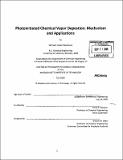Photoinitiated chemical vapor depostion [sic] : mechanism and applications
Author(s)
Baxamusa, Salmaan Husain
DownloadFull printable version (12.17Mb)
Alternative title
Photoinitiated chemical vapor deposition : mechanism and applications
Other Contributors
Massachusetts Institute of Technology. Dept. of Chemical Engineering.
Advisor
Karen K. Gleason.
Terms of use
Metadata
Show full item recordAbstract
Photoinitiated chemical vapor deposition (piCVD) is developed as a simple, solventless, and rapid method for the deposition of swellable hydrogels and functional hydrogel copolymers. Mechanistic experiments show that piCVD is predominantly a surface reaction, allowing it to coat non-planar geometries such as particles. The process is gentle enough to coat delicate optical sensors without degrading their function. Chemically functional hydrogels can be synthesized by incorporating a comonomer, and this functionality can be nanoconfined to the near surface region. Random amphiphilic copolymer films deposited via piCVD represent a novel polymer film system, and these surfaces present molecular-scale compositional heterogeneities that interfere with protein adsorption events. Also described is the mechanism by which thin films form on non-planar geometries via initiated chemical vapor deposition (iCVD) . The conformality of these films in microtrenches is assessed and an analytical model is developed in order to quantify the sticking probability of the initiating radical. Mechanistic insight from these experiments is used to predict the conformality based on the fractional saturation of the monomer vapor.
Description
Thesis (Ph. D.)--Massachusetts Institute of Technology, Dept. of Chemical Engineering, 2009. Cataloged from PDF version of thesis. Includes bibliographical references.
Date issued
2009Department
Massachusetts Institute of Technology. Department of Chemical EngineeringPublisher
Massachusetts Institute of Technology
Keywords
Chemical Engineering.